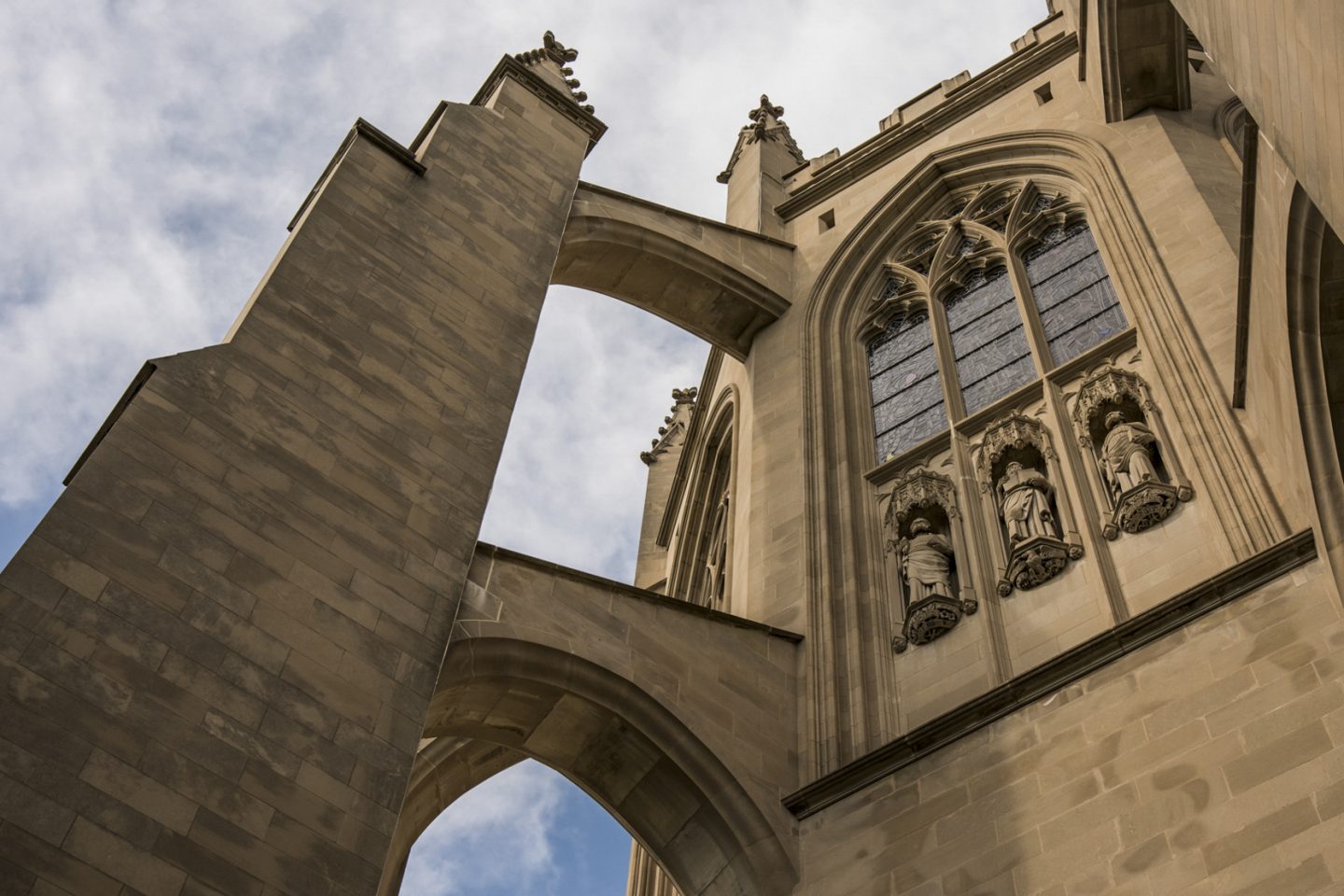
Gothic Architecture 101
The Cathedral took exactly 83 years to complete, using centuries-old building techniques that originated in the Middle Ages. Learn about the architectural features that make this building unlike any other in the nation's capital.
Gothic architecture originated in France and became wildly popular throughout Europe from the 12th century to the 15th century. Prior to Gothic architecture, most churches were Romanesque in style and featured thick walls, small windows and rounded arches.
Gothic architecture revolutionized church design by allowing churches to be larger, taller and filled with rainbows of light from large stained glass windows.
Washington National Cathedral is the sixth-largest Cathedral in the world and was built in a 14th Century English Gothic design. The first Episcopal bishop of Washington, the Right Rev. Henry Yates Satterlee, decreed that Gothic was God’s preferred architectural stye.
Most Gothic churches are built facing West, in the shape of a cross. The central part of the Cathedral is called the nave; the two arms of the cross are called transepts and the head of the cross is called the apse.
Arches
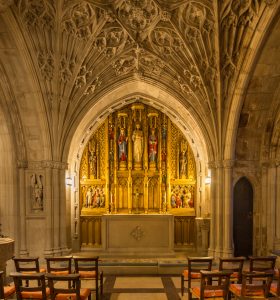 One of the most visually distinct elements of Gothic architecture is the pointed arch, employed in everything from arched ceilings to door frames and large pointed windows. Pointed arches are often associated with Gothic architecture, but were actually used much earlier in Islamic and Middle Eastern architecture.
One of the most visually distinct elements of Gothic architecture is the pointed arch, employed in everything from arched ceilings to door frames and large pointed windows. Pointed arches are often associated with Gothic architecture, but were actually used much earlier in Islamic and Middle Eastern architecture.
The loftiness of the pointed arches also draw the eye upward and contribute to the Gothic style of verticality and soaring heights. Arched Gothic windows typically contain one or more individual vertical panes called lancets; the name derives from their association with the pointed devices used in medicine.
Boss stones

In the Cathedral’s spectacular vaulted ceiling, round boss stones are key structural and decorative elements. Each stone in the center of the arch functions like a keystone; without these load-bearing stones, the massive weight of the ceiling could not be suspended for such immense spans. Across the Cathedral, there are some 762 boss stones (the largest weighs 5 tons), and only the 14th-century cathedral in Norwich, England, has more carved boss stones.
Starting in the west end and working toward the High Altar at the east end, the boss stones depict theological statements from the Nicene Creed and Apostles’ Creed, staring with “I believe in God the Father Almighty” and ending with “I believe in the life of the world to come.” Just as the stones provide the structural support for the sacred space, the statements on those keystones reflect the theological backbone of the Cathedral.
Buttresses
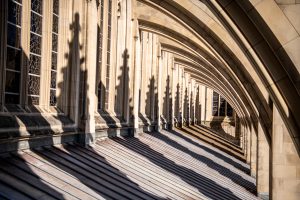 The flying buttress is one of the most recognizable elements of Gothic church architecture. The buttresses resist the outward push of the interior arches and vaulted ceiling that would push a wall outward, and redirect those forces down into the ground.
The flying buttress is one of the most recognizable elements of Gothic church architecture. The buttresses resist the outward push of the interior arches and vaulted ceiling that would push a wall outward, and redirect those forces down into the ground.
In other words, the buttresses take the weight of the roof and the vaulted ceiling that would normally put pressure on the walls. Rather than push the walls out, the buttresses take that weight and redirect it down into the ground.
Flying buttresses “fly” because the buttress is not in contact with the wall all the way to the ground; the lateral forces are transmitted across an intervening space. Flying buttresses have two key parts: a massive vertical masonry pier on the outside of the building, and an arch that bridges the gap between the buttress and the wall of the Cathedral.
Some of the building elements that suffered the most damage as a result of the 2011 earthquake were the six flying buttresses on the Cathedral’s east end. When construction began in 1907, there was no reinforcement used between stones. The seismic motion caused stones in the buttresses to shift and separate and loosen. Those buttresses are now completely restored.
Gargoyles and grotesques
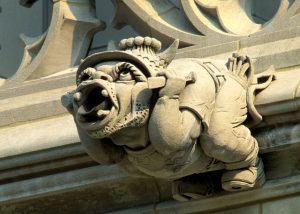 A stone building’s biggest enemy is water, which can seep into cracks and damage the stone. Gargoyles are basically intricately carved water spouts that function like elaborate gutters to draw water away from the limestone walls.
A stone building’s biggest enemy is water, which can seep into cracks and damage the stone. Gargoyles are basically intricately carved water spouts that function like elaborate gutters to draw water away from the limestone walls.
In medieval times, these carved down spouts were originally designed to repel evil spirits. Their function is actually more practical, and allowed stone carvers to apply an artistic and whimsical element to the Cathedral’s architecture. The Cathedral has 112 functioning gargoyles.
Grotesques are carved elements, but do not act as traditional water spouts. The more than 1,000 grotesques also help protect the stone; when rain drops bounce off their heads or noses, that helps keep the water away from the walls. Grotesques range from angels to animals to the most popular, a likeness of Darth Vader that was carved in 1986 as part of a children’s contest.
Pinnacles
 Sure, pinnacles are decorative and intricately carved, but they also serve a key purpose in Gothic architecture.
Sure, pinnacles are decorative and intricately carved, but they also serve a key purpose in Gothic architecture.
A pinnacle is an architectural ornament that forms the cap, or crown, of a buttress or small turret. A pinnacle looks like a small spire. In addition to adding to the loftiness and verticality of the structure, the pinnacles are very heavy and enable the flying buttresses to counteract the weight of the vaulted ceiling and roof. By adding compressive stress (a result of the pinnacle weight), the building’s load is shifted downward rather than sideways.
Finials are the topmost portion of a pinnacle, often sculpted as a leaf-like ornament with an upright stem and a cluster of crockets – imagine a stem of brussel sprouts, and you’ll get the idea. Crockets are projected pieces of carved stone that decorate the sloping ridges of pinnacles. The carved shapes of these elements help move rainwater down while keeping the water from the roof or walls.
More than 75 percent of the Cathedral’s pinnacles were damaged in the 2011 earthquake as the seismic waves traveled up through the building and rotated the elegant pinnacle stones in different directions.
Stained glass windows
 Prior to Gothic architecture, most churches were built with heavy thick walls and small windows. Gothic architecture allowed the walls to be thinner and to rise higher, and opened vast expanses for dramatic windows that could be used to convey visual representations of biblical teachings.
Prior to Gothic architecture, most churches were built with heavy thick walls and small windows. Gothic architecture allowed the walls to be thinner and to rise higher, and opened vast expanses for dramatic windows that could be used to convey visual representations of biblical teachings.
The Cathedral contains more than 200 stained glass windows of all shapes and sizes. The windows are grouped in various themes, such as professions, heroes of church history, stories of the Hebrew Scriptures and the humanities. Style range from classical to more modern and impressionistic, and often reflect artistic sensibilities of the era in which they were designed and installed.
Many windows at the Cathedral overlay stories of biblical history and American history; the Job window, for example, depicts human suffering against the backdrop of a military cemetery. Images of the White House, U.S. Capitol and Supreme Court appear in large clerestory windows that pair the development of the Hebrew nation with the American people.
Tympanum
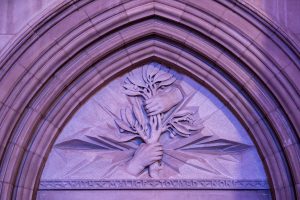 A Tympanum is the triangle-shaped area above a door that is set within a Gothic arch. Here at the Cathedral, many of the tympanum entrances are intricately carved with different motifs: the main portals on the West front depict the creation of humanity, day and night; the north porch honors women and the Virgin Mary; the South porch depicts pilgrims and saints gathered around the Last Supper; and an interior tympanum dedicated to the Civil War features Northern and Southern hands grasping an olive branch in a quest for peace.
A Tympanum is the triangle-shaped area above a door that is set within a Gothic arch. Here at the Cathedral, many of the tympanum entrances are intricately carved with different motifs: the main portals on the West front depict the creation of humanity, day and night; the north porch honors women and the Virgin Mary; the South porch depicts pilgrims and saints gathered around the Last Supper; and an interior tympanum dedicated to the Civil War features Northern and Southern hands grasping an olive branch in a quest for peace.
Vaulted ceiling
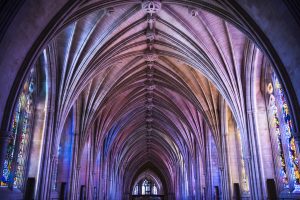 The vaulted ceiling provides support for the airy roof, but also spells out the theological underpinnings of the Christian faith.
The vaulted ceiling provides support for the airy roof, but also spells out the theological underpinnings of the Christian faith.
Look seven stories up and you’ll be amazed by a central architectural feature of Gothic cathedrals, the vaulted ceiling, which transmits the weight of the roof and walls across delicate ribs and down the heavy trunks of stone piers.
Washington National Cathedral displays a range of vault styles, from simple barrel and groin vaults in the crypt to elaborate fan vaulting in Children’s Chapel. Most of the nave features ribbed vaulting, which is designed to be both elegant, simple and functional. The weight and downward thrust of the vaulted ceiling is dispersed to the piers, or columns, and outward through the walls to buttresses, which carry the weight down into the ground.